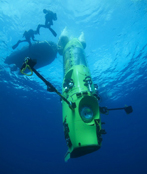James Cameron's Record Dive Exposes Need For Global Protection Of The High Seas
 Yesterday, filmmaker James Cameron became the first solo explorer to reach the ocean’s deepest point, traveling nearly seven miles down through some of the darkest, most mysterious waters on Earth. Cameron’s successful venture to the bottom of the Mariana Trench comes at a pivotal time for the deep ocean. As world leaders prepare for a June meeting in Brazil to discuss the future of our planet’s resources, the fate of the deep ocean is at stake.
Yesterday, filmmaker James Cameron became the first solo explorer to reach the ocean’s deepest point, traveling nearly seven miles down through some of the darkest, most mysterious waters on Earth. Cameron’s successful venture to the bottom of the Mariana Trench comes at a pivotal time for the deep ocean. As world leaders prepare for a June meeting in Brazil to discuss the future of our planet’s resources, the fate of the deep ocean is at stake.In just 12 weeks, heads of state from around the world will gather in Rio de Janeiro for a major global summit on the planet’s future. Known as the “Earth Summit,” this meeting addresses the health of our climate, air, food sources, fresh water, and oceans. This meeting is vastly important—the last time world leaders gathered like this to discuss broad environmental concerns was a full ten years ago. It is essential that leaders at the 2012 Earth Summit address the future of some of our most vulnerable ocean space, the high seas.
Half of the Earth is covered by a vast global commons—that portion of the deep ocean that lies beyond the jurisdiction of any one country. Known as the “high seas,” this area of international waters (present in all regions of the globe) constitutes two thirds of the world’s oceans. The only way to ensure the health of the high seas is through international cooperation. And as this enormous area is increasingly threatened by deep sea mining, overfishing, ocean warming, acidification, and plastic and noise pollution, protecting the high seas is getting harder and harder every day.
Adding to the hurdles of protecting this crucial ocean area is the outdated and gap-ridden legal regime under which human activities—including fishing, shipping, energy production, and others—are managed.
While marine parks in the high seas would allow sea life to thrive protected from industrial activities, no legal mechanism exists to establish such areas in the high seas. Prior environmental impact assessment is required for some activities in the high seas, like mining, but not for others, including certain types of fishing. The standards are also inconsistent, differing widely among sectors.
As we saw during James Cameron’s journey, much of the high seas lies so deep that even sunlight cannot penetrate to the ocean floor. The marine life there—from bioluminescent organisms to exotic microbes—remains largely a mystery to us, so much so that Cameron once dubbed the deep ocean an “alien world here on Earth.”
If we are going to conserve, protect, and continue to learn from the amazing array of life in the deep, the existing legal regime needs a major overhaul.
The good news is that there is growing support for a new treaty that would protect ocean life beyond national jurisdiction. Such an agreement could clear the way for establishing fully protected parks on the high seas, require prior assessment for all activities, and address a variety of other management gaps.
It is essential that when our global leaders head to the 2012 Earth Summit in June, they launch negotiations to protect the high seas as a matter of urgency. This vast ocean area is critical to the health of our planet, our way of life, and the well-being of all nations.
You can return to the main Market News page, or press the Back button on your browser.

